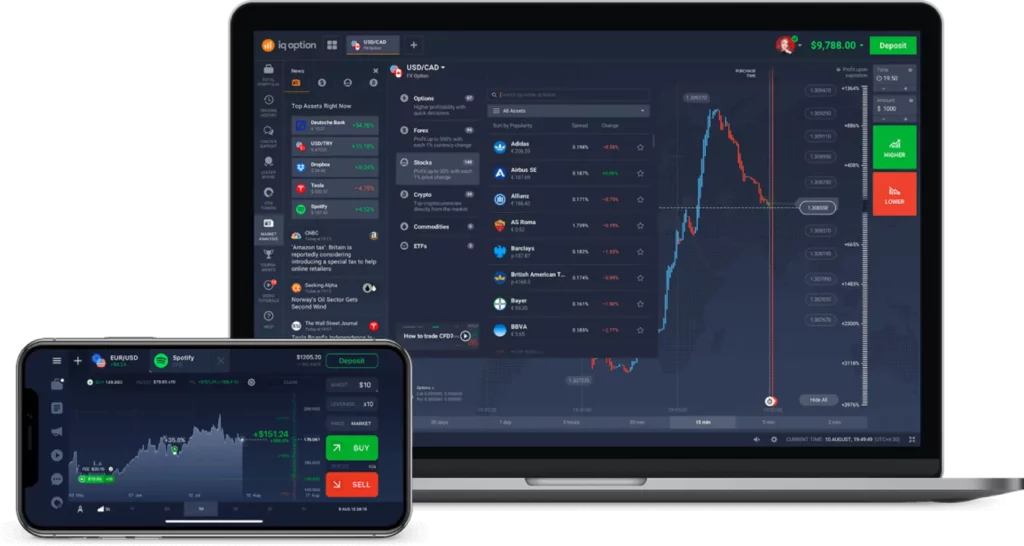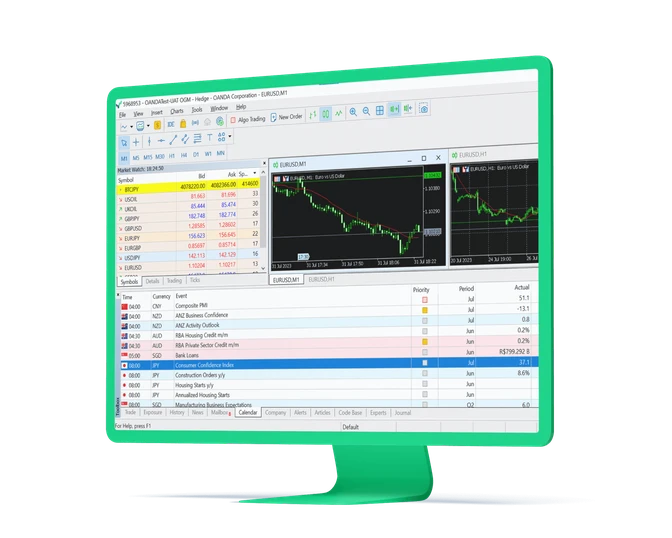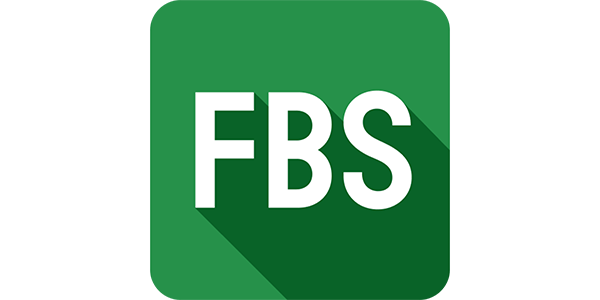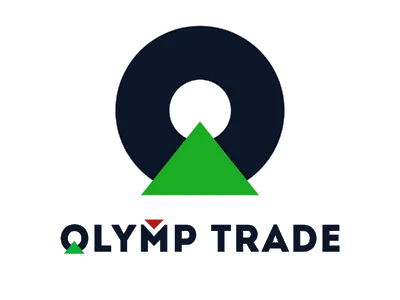Top-Rated Trading Platforms by Functionality
Here’s a look at some of the most trusted trading apps available today. These platforms stand out for their consistent performance, broad market access, and trader-focused design.
To make it easier to compare them side by side, the table below outlines the most important trading specifications for each platform—commission structure, supported instruments, minimum deposit, leverage, and available platforms.
| Best For | Commision | Min Dep | Leverage | Platforms | ||
|---|---|---|---|---|---|---|
| Social & Copy Traders, Beginners | $0 (spread-based) | $10 | Up to 1:30 | eToro App Web iOS Android | ||
| Beginners, Technical Analysts | $0 (via spreads) | $100 | Up to 1:400 | AvaTradeGO MT4 MT5 | ||
| Options, Short-Term Traders | Spread-based model | $10 | Up to 1:500 | IQ Option App Web | ||
| CFD Traders, Experienced Users | $0 (spread-only) | $100 | Up to 1:30 | Plus500 App Web Mobile | ||
| Professionals, Scalpers | $0 (spread-only) | $50 | Up to 1:500 | xStation 5 Web Mobile | ||
| Multi-Asset Traders, CopyFX Users | From $0 (depends on account) | $10 | Up to 1:2000 | R MobileTrader MT4 MT5 | ||
| Scalpers, Algo Traders, Professionals | Raw spreads + $3.50 per lot | $200 | Up to 1:500 | cTrader MT4 MT5 Mobile | ||
| Professionals, Institutional Investors | Tiered ($0–$0.005/share) | $0 | Up to 1:50 | IBKR Mobile Web Trader Desktop | ||
| Beginners, Small Accounts | $0–$2 per lot | $1 | Up to 1:3000 | FBS Trader App MT4 MT5 | ||
| Short-Term & Fixed-Time Traders | No commission (fixed spreads) | $10 | Up to 1:400 | Olymp Trade App Web | ||
| CFD & Synthetic Index Traders | $0 (spread-based) | $5 | Up to 1:1000 | DTrader DMT5 Deriv GO DBot | ||
| Digital Options & Crypto Traders | $0 (spread included) | $5–$10 | Up to 1:100 | Pocket Option App Web |
eToro
eToro
eToro remains one of the most widely recognized trading platforms worldwide. Its mobile application stands out for its intuitive interface and innovative CopyTrading feature, which allows users to replicate the strategies of experienced traders in real time.
Key Highlights:
- Access to stocks, cryptocurrencies, ETFs, and CFDs.
- Integrated social trading feed for market discussions.
- Competitive spreads and transparent commission structure.
- Real-time analytics and sentiment indicators.
Pros:
- Excellent user interface for beginners and professionals.
- Wide market coverage.
- Fast execution speed on both Wi-Fi and mobile data.
Cons:
- Some instruments have overnight fees.
- Cryptocurrency transfers may require identity verification.
eToro Mobile App Overview
| Feature | Details |
| Markets Available | Forex, Stocks, Crypto, ETFs, Indices |
| Minimum Deposit | $10 |
| Regulation | FCA, CySEC, ASIC |
| Notable Function | CopyTrading system |
| Mobile Platform Availability | iOS, Android |
AvaTradeGO
AvaTradeGO
AvaTradeGO provides a refined mobile experience with powerful analytical tools integrated into an elegant interface. The app includes risk management controls and integrates smoothly with MetaTrader accounts, making it suitable for both casual traders and technical analysts.
Key Highlights:
- AvaProtect™ tool for reducing potential loss exposure.
- Market Trends feature with live data and sentiment scores.
- Supports automated strategies and mobile notifications.
Pros:
- Fast account synchronization across platforms.
- Educational resources integrated into the app.
- Detailed performance insights.
Cons:
- Limited customization in chart layouts.
- Certain features unavailable in some regions.
AvaTradeGO Summary
| Feature | Specification |
| Main Instruments | Forex, Commodities, Indices, Cryptocurrencies |
| Risk Management Tool | AvaProtect™ |
| Execution Type | Market/Instant |
| Minimum Deposit | $100 |
| Mobile Platforms | iOS, Android |
IQ Option
IQ Option
IQ Option remains popular among short-term and options traders. It is particularly valued for its demo account and smooth interface that helps users understand market mechanics without risking real funds.
Key Highlights:
- Interactive charting tools and multi-asset accessibility.
- Practice account with $10,000 virtual balance.
- Flexible trade sizes starting from $1.
Pros:
- Excellent for learning price action strategies.
- Quick access to various instruments from a single dashboard.
- Fast customer feedback through integrated chat.
Cons:
- Some markets have limited trading hours.
- Withdrawals can take longer depending on the payment method.
List: Notable Tools in IQ Option App
- Multi-window charting
- Technical indicators (MACD, RSI, Bollinger Bands)
- Historical price data access
- Economic calendar integration
Plus500
Plus500
Plus500’s mobile application delivers a professional-grade trading experience with an emphasis on precision and stability. It’s known for its CFD offerings and clear presentation of margin requirements.
Key Highlights:
- More than 2,800 CFDs available across markets.
- Real-time risk management and margin control.
- Advanced chart analysis with over 100 indicators.
- Push alerts for price levels and volatility updates.
Pros:
- Regulated in multiple jurisdictions.
- Commission-free trading with built-in spreads.
- Smooth and intuitive layout.
Cons:
- No social trading functions.
- No integration with MetaTrader platforms.
Plus500 Mobile Features
| Category | Information |
| Markets Covered | Forex, Commodities, Stocks, Indices, ETFs |
| Minimum Deposit | $100 |
| Regulation | FCA, CySEC, ASIC, FMA |
| Leverage Range | Up to 1:30 |
| Chart Tools | 100+ Indicators |
XTB
XTB
XTB’s xStation app has become one of the most advanced trading solutions available for mobile users. It delivers lightning-fast execution and integrates deeply with economic data streams.
Key Highlights:
- xStation 5 platform known for real-time execution and deep analytics.
- Built-in newsfeed and economic calendar.
- Price alerts and performance analytics in one dashboard.
- Negative balance protection by default.
Pros:
- Regulated by top-tier authorities.
- Easy-to-use yet powerful analytics interface.
- Transparent pricing structure.
Cons:
- Limited access to exotic instruments.
- Slightly higher spreads on minor currency pairs.
Quick Comparison List: Why Traders Prefer XTB
- Fast execution speed suitable for scalping.
- Strong regulatory background (FCA, KNF, CySEC).
- Advanced risk management tools.
- Detailed market statistics accessible in real time.
RoboForex
RoboForex
RoboForex offers one of the most versatile trading ecosystems on the market. Its mobile platform, R MobileTrader, combines advanced order management with a clean interface that simplifies navigation across more than 12,000 instruments. The app is suitable for traders who value flexibility and execution speed without sacrificing analytics.
Key Highlights:
- Wide range of assets, including Forex pairs, CFDs, and global stocks.
- Instant order placement and integrated price alerts.
- Analytical widgets with real-time updates.
Pros:
- Access to multiple account types with adjustable leverage.
- Stable app performance even with high market volatility.
- Built-in option to copy trades from top performers.
Cons:
- Some regional restrictions limit access to specific tools.
- Interface customization is limited compared to MetaTrader.
RoboForex App Snapshot
| Parameter | Description |
| Tradable Instruments | 12,000+ assets across markets |
| App Name | R MobileTrader |
| Account Options | Pro, ECN, Prime, CopyFX |
| Regulation | IFSC Belize |
| Minimum Deposit | $10 |
Pepperstone
Pepperstone
Pepperstone’s proprietary mobile application provides access to global markets through an elegant and high-speed interface. Designed for serious traders, it balances simplicity with professional-grade analytics, ensuring that essential data is always available in real time.
Key Highlights:
- Supports more than 1,200 instruments, including Forex, indices, and commodities.
- “Quick Switch View” mode for simultaneous chart monitoring.
- Fast execution speeds with minimal slippage.
Pros:
- Transparent pricing and competitive spreads.
- Regulated by multiple financial authorities.
- Efficient mobile order management.
Cons:
- Fewer integrated tutorials than beginner-oriented apps.
- Some advanced order types available only on desktop platforms.
Pepperstone Mobile Overview
| Specification | Details |
| Instruments Offered | Forex, Commodities, Indices, Shares CFDs |
| Execution Model | STP / ECN |
| Regulation | ASIC, FCA, DFSA |
| Platform Availability | iOS, Android |
| Best For | Active traders and scalpers |
Interactive Brokers
Interactive Brokers
Interactive Brokers’ mobile app delivers professional-grade access to global exchanges. It is designed for investors who require deep market data, complex order types, and exposure to multiple asset classes in one place.
Key Highlights:
- Global connectivity with real-time access to 135+ markets.
- Detailed order control, margin tracking, and smart routing.
- Comprehensive reporting and portfolio analysis tools.
Pros:
- Suitable for managing large portfolios or institutional strategies.
- Outstanding stability and execution quality.
- Extensive customization of interface and alerts.
Cons:
- Steeper learning curve for beginners.
- Requires stable connectivity for full functionality.
Interactive Brokers Mobile Key Data
| Aspect | Information |
| Supported Assets | Stocks, ETFs, Options, Futures, Forex |
| Advanced Features | SmartRouting, Portfolio Analysis |
| Regulation | SEC, FCA, ASIC, IIROC |
| Best For | Experienced and professional traders |
FBS Trader
FBS Trader
FBS Trader focuses on accessibility and simplicity. The platform provides core trading tools and fast order execution, allowing users to trade Forex and CFDs directly from their smartphones without unnecessary complications.
Key Highlights:
- Intuitive navigation for instant order entry.
- Small minimum deposit requirements.
- Access to both real and demo accounts for learning and practice.
Pros:
- Ideal for traders with limited starting capital.
- Quick verification and easy balance tracking.
- Regular market updates through in-app notifications.
Cons:
- Chart customization is limited compared to advanced platforms.
- Some instruments unavailable depending on account type.
FBS Trader Summary
| Element | Detail |
| Primary Assets | Forex, Metals, CFDs |
| Minimum Deposit | $1 |
| Regulation | IFSC Belize, CySEC |
| Trading Interface | FBS Trader Mobile App |
| Demo Account | Available |
Capital.com
Capital.com
Capital.com stands out for its modern interface and powerful analytics engine integrated into a lightweight mobile design. It’s one of the few brokers offering over 3,000 markets within a platform that feels genuinely optimized for mobile users.
Key Highlights:
- Real-time charting with 70+ indicators.
- AI-based market analysis for personalized insights.
- Educational section built into the app.
Pros:
- Smooth performance with intuitive navigation.
- Commission-free model with transparent spreads.
- Suitable for both short-term and positional strategies.
Cons:
- Spread values vary across instruments.
- Limited tools for algorithmic strategy deployment.
Capital.com Mobile Platform Overview
| Metric | Value |
| Markets | 3,000+ (Forex, Indices, Crypto, Shares) |
| Regulation | FCA, CySEC, ASIC |
| Learning Resources | Articles, video lessons, courses |
| Minimum Deposit | $20 |
| Order Execution Speed | Instant (under normal market conditions) |
Olymp Trade
Olymp Trade
Olymp Trade appeals to traders who prefer a simple and structured approach. Its mobile app offers clear charting, fixed-time trading modes, and accessible entry requirements, making it suitable for users exploring shorter-term market opportunities.
Key Highlights:
- Practice account preloaded with virtual funds.
- Multiple chart types and trading modes.
- Designed for clear trade execution with fast confirmations.
Pros:
- Easy onboarding and quick setup.
- Works efficiently on low-performance devices.
- Active in-app statistics and educational prompts.
Cons:
- Not all regions offer full functionality.
- Fewer regulatory protections compared to larger brokers.
Olymp Trade Overview
| Feature | Specification |
| Main Markets | Forex, Commodities, Crypto, Indices |
| Demo Account | Yes |
| Platform Type | Proprietary |
| Minimum Trade Amount | $1 |
| Minimum Deposit | $10 |
Deriv
Deriv
Deriv combines traditional CFD trading with unique products such as synthetic indices. Its mobile platform focuses on flexibility, offering both manual trading and bot automation within the same ecosystem.
Key Highlights:
- Supports CFDs, multipliers, and synthetic indices.
- Integration with trading bots and API tools.
- Simple interface suitable for both manual and automated strategies.
Pros:
- Low entry threshold with minimum deposits starting from $5.
- Cross-device synchronization between mobile and web apps.
- Option to create custom trading algorithms.
Cons:
- Limited availability of certain instruments depending on region.
- Offshore regulation in some jurisdictions.
Deriv App Information
| Detail | Description |
| Supported Assets | Forex, CFDs, Synthetic Indices |
| Platform Types | DTrader, DBot, DMT5, Deriv GO |
| Regulation | MFSA, Labuan FSA, VFSC |
| Minimum Deposit | From $5 |
| Best For | Flexible and experimental strategies |
Pocket Option
Pocket Option
Pocket Option is a mobile-first platform specializing in digital options and short-term trading instruments. It’s recognized for its minimal deposit requirements and user-friendly interface designed for quick execution.
Key Highlights:
- Over 100 assets including currencies, crypto, and stocks.
- Demo mode available instantly after installation.
- In-app tournaments and achievements for active users.
Pros:
- Fast setup and clear order interface.
- Low minimum deposit, accessible worldwide.
- Simple performance tracking with visual statistics.
Cons:
- Limited regulation compared to major brokers.
- Binary trading instruments carry higher risk levels.
Pocket Option Summary
| Category | Value |
| Tradable Assets | 100+ (Forex, Crypto, Stocks, Commodities) |
| Platform Type | Mobile / Web |
| Minimum Deposit | $5–$10 |
| Demo Availability | Yes |
| Trading Mode | Digital and short-term options |
What Makes a Trading App Reliable?
Reliability is not a bonus—it’s a necessity. If execution is delayed, data is inaccurate, or features are missing during critical moments, losses can compound quickly. Traders often associate reliability with execution, but it encompasses much more: security, regulation, data quality, and user infrastructure. Below is a breakdown of core traits that define a dependable trading platform.
Fast and Accurate Execution
Order execution speed is vital. Slippage, re-quotes, or failed orders during high volatility can distort strategy results, especially for intraday or scalping traders. A trading app should connect directly to a broker’s liquidity providers and show accurate spreads without lags.
Execution Speed Comparison
| Platform | Average Order Execution Speed | Slippage Protection | One-Click Trading |
|---|---|---|---|
| eToro | ~120ms | Partial (via Market Orders) | Yes |
| AvaTradeGO | ~100ms | Yes (AvaProtect™ for loss coverage) | Yes |
| IQ Option | ~90ms | Partial | Yes |
| Plus500 | ~70ms | Yes (Guaranteed Stop available) | Yes |
| XTB | ~50ms | Yes (via xStation risk management) | Yes |
Note: Execution speed may vary depending on internet connection, broker server location, and account type.
User-Friendly Interface
A reliable trading app must feel intuitive. Navigation should not require tutorials or frequent customer assistance. Traders should be able to open/close trades, analyze charts, switch timeframes, or adjust orders without extra effort.
Key interface features to check:
- Customizable watchlists
- One-tap trade buttons
- Responsive design for mobile/tablet
- Real-time sync with desktop versions
Avoid cluttered interfaces with too many popups or delayed menus. Efficient layout reduces the chance of operational errors during fast-paced trades.
Access to Multiple Asset Classes
Limiting an app to only one asset type (like forex or stocks) restricts strategy development. A solid app should offer access to multiple instruments:
- Currency pairs
- Stocks and ETFs
- Indices
- Commodities (gold, oil)
- Cryptocurrencies
- Bonds and options (where applicable)
Asset Class Access by App
| Asset Class Access by App | eToro | AvaTradeGO | IQ Option | Plus500 | XTB |
|---|---|---|---|---|---|
| Forex | ✔ | ✔ | ✔ | ✔ | ✔ |
| Stocks | ✔ | ✔ | ✔ | ✔ | ✔ |
| Crypto | ✔ | ✔ | ✔ | ✔ | ✔ |
| Indices | ✔ | ✔ | ✔ | ✔ | ✔ |
| Commodities | ✔ | ✔ | ✔ | ✔ | ✔ |
Choosing a platform with multi-asset support allows better diversification, asset rotation, and hedging options.
Flexible Deposit and Withdrawal Options
Reliability also shows in how easily funds can move in and out of an account. A trading app should display clear options for:
- Card payments (Visa/Mastercard)
- Local bank transfers
- E-wallets (Skrill, Neteller)
- Crypto wallets (Bitcoin, USDT, etc.)
Processing time and fees should be shown upfront. The app should offer internal notifications for withdrawals and confirmations.
What to look for:
- Same-day processing
- Fee-free internal transfers between accounts
- Real-time balance updates
Apps with built-in finance tabs and visual transaction history make it easier to track cash flow, avoiding confusion during margin calls or lot-size adjustments.
Security Features and Regulation
Trading with unregulated brokers or unsecured apps is dangerous. Encryption, biometric login, and account lock features are standard now—but regulatory backing gives true peace of mind.
Security checklist:
- Two-factor authentication (2FA)
- Regulation by tier-1 authorities (FCA, CySEC, ASIC)
- SSL encryption of all sessions
- Segregated funds for client capital
- KYC-compliant interface
If an app lacks visible licensing or shows unusual login behavior, avoid trading real money on it.
Real-Time Market Data and Analysis Tools
Live prices and chart tools are a must. Lagging prices or outdated quotes can skew entries, especially when trading volatile pairs or news-based strategies. A strong app should offer:
- Level I/II data access
- Tick charts and historical data
- Live economic calendar
- Push notifications for market events
Many platforms now integrate AI or sentiment-based tools. While useful, they should not replace raw data tools like candlestick patterns, volume profiles, or Bollinger bands.
Key Features to Consider Before Choosing a Trading App
Not every platform is built for every trader. Some are geared toward short-term execution, others prioritize long-term asset allocation. Before downloading or registering with any trading app, review the following core features. Compatibility with your trading style often depends on how well these tools are implemented.

Supported Instruments (Forex, Stocks, Crypto, etc.)
Versatility in tradable assets isn’t just a convenience—it’s a strategic necessity. Apps should offer a wide variety of instruments to suit both diversified and specialized portfolios.
When evaluating apps, examine:
- Number of forex pairs (majors, minors, exotics)
- Range of stocks from global exchanges
- Available cryptocurrencies (BTC, ETH, etc.)
- Commodities: oil, gold, silver
- Indices: S&P 500, DAX, FTSE
- Bonds, ETFs, options (for advanced traders)
Instruments Comparison
| App | Forex Pairs | Stocks | Crypto | Indices | Commodities |
|---|---|---|---|---|---|
| RoboForex | ✔ | ✔ | ✔ | ✔ | ✔ |
| Pepperstone | ✔ | ✔ | ✔ | ✔ | ✔ |
| Interactive Brokers | ✔ | ✔ | ✔ | ✔ | ✔ |
| FBS Trader | ✔ | ✖ | ✔ | ✔ | ✔ |
| Capital.com | ✔ | ✔ | ✔ | ✔ | ✔ |
| Olymp Trade | ✔ | ✖ | ✔ | ✔ | ✔ |
Order Types and Execution Modes
Precision in execution is critical. A solid app must support multiple order types that match market conditions and trading strategies. Execution modes should be quick and transparent, especially during volatility.
Key order types to check:
- Market orders
- Limit and stop orders
- Trailing stops
- One-Cancels-the-Other (OCO)
- Take profit and stop-loss integration
Execution modes matter just as much:
- Instant execution (fixed spread, fixed price)
- Market execution (floating spread, fast fills)
- Pending execution (entry at a specified price)
- Fill or kill (for institutional-style entries)
Some apps provide access to Depth of Market (DOM) to assist in volume-based strategies, particularly useful for scalpers and day traders.
Customization and Charting Tools
Charts are the trader’s cockpit. Limited or outdated charting can distort decision-making. Customizable workspaces, multi-chart layouts, and detailed indicators are signs of a refined app.
Advanced charting features include:
- Multiple timeframes (from 1-second to monthly)
- Zoom, scroll, and full-screen views
- Custom indicators and drawing tools
- Candlestick, Heikin Ashi, Renko, and line charts
- Strategy backtesting using historical data
Chart Tools Available by App
| App | Timeframes 1s-Monthly | Custom Indicators | Drawing Tools | Strategy Testing |
|---|---|---|---|---|
| RoboForex | 21 | ✔ | ✔ | ✔ |
| Pepperstone | 30+ | ✔ | ✔ | ✔ |
| Interactive Brokers | 25+ | ✔ | ✔ | ✔ |
| FBS Trader | 12 | ✔ | ✔ | Limited |
| Capital.com | 21 | ✔ | ✔ | ✔ |
| Olymp Trade | 9 | ✔ | ✔ | Partial |
Choose apps with cloud-based templates and layouts. This ensures consistent views across devices.
Availability of Automated Trading Tools
Automated trading isn’t just for institutions anymore. Many apps now allow integration of algorithmic systems or offer built-in automation. Look for platforms that support:
- Expert Advisors (EAs) & trading bots
- No-code strategy builders
- Code integration: MQL4/5, Python, C#
- API access for custom solutions
- Real-time logs & optimization reports

Mobile vs Desktop Functionalities
Mobile trading has advanced rapidly, but not all apps match their desktop counterparts. Understand what’s missing on mobile before committing.
Features Often Missing on Mobile:
- Complex order management (OCO, bracket orders)
- Full market depth
- Multiscreen layouts
- Custom indicators/scripts
- Detailed reporting modules
Mobile vs Desktop Feature Snapshot
| Feature | Mobile | Desktop |
| Basic charting | ✔ | ✔ |
| Advanced indicators | ✔ | ✔ |
| Strategy testing | ✖ | ✔ |
| Automated trading | ✖ | ✔ |
| Multi-window layout | ✖ | ✔ |
For swing or long-term traders, mobile tools may suffice. However, day traders should favor desktop versions when using precision tools or bots.
How to Choose the Right App for Your Strategy
Every trading approach requires a specific set of tools. Scalping needs fast execution and low latency. Swing trading relies on robust technical analysis. Algorithmic systems demand scriptable environments, while long-term investing favors portfolio monitoring and simplicity.
Matching the app with your method is essential for consistency and accuracy. Below is a breakdown of how to align platform features with trading styles.
Day Trading
Day trading demands precision, speed, and constant monitoring. Slippage, delays, or restricted order types can ruin short-term setups.
What to prioritize:
- Instant and market execution
- Tight spreads with live updates
- Hotkeys and one-click order buttons
- Real-time charting with tick and minute intervals
- Ability to manage multiple open trades with active stop management
Best platforms for day trading:
- eToro – Low latency with Level II data
- IQ Option – Mobile-friendly with quad-screen view
- AvaTradeGO – Full control over order flow and order books
Swing Trading
Swing traders hold positions for several days or weeks, relying heavily on price patterns, technical indicators, and trend confirmation.
Important features:
- Clean and customizable charting
- Reliable alert systems (price, indicator-based)
- Drawing tools (Fibonacci, trendlines, channels)
- Multi-timeframe analysis
- Fundamental data and macroeconomic calendar access
Recommended apps:
- Plus500 – Best-in-class charting and scripting
- Capital.com – Smart indicators with educational alerts
Swing traders benefit most from platforms that combine charting, alerting, and analysis with less focus on rapid order execution.
Algorithmic Trading
Traders building automated systems require scriptable platforms with access to historical data, custom indicators, and stress testing.
Technical needs:
- Strategy scripting languages (MQL4/5, Pine Script, C#)
- Backtesting with tick or bar data
- Simulated environments (paper trading, market replay)
- Real-time logs and error handling
- VPS integration (for 24/7 automation)
Best picks:
- AvaTradeGO – Full IDE-style environment with NinjaScript
- RoboForex – Uses cAlgo for bot deployment
- Pepperstone – Ideal for alert-based automation with Pine Script
Note: Not all platforms allow server-side bot execution. Check if your broker offers VPS support when using automated strategies.
Long-Term Investing
Investors focus on stability, research tools, portfolio tracking, and access to real economic data.
Key platform traits:
- Easy asset monitoring over months or years
- Built-in fundamental research
- Access to global equities and ETFs
- Watchlists and dividend tracking
- Integrated news feeds and analyst reports
Top platforms for investors:
- eToro – Copy portfolio tools and user performance stats
- AvaTradeGO – Advanced portfolio management tools
- RoboForex – Thinkorswim platform with news integration
Apps for long-term use should emphasize simplicity, informative dashboards, and secure account management.
Common Mistakes to Avoid When Using Trading Apps
Even with the most advanced trading app, strategic errors and poor habits can erode performance. Mobile tools are powerful, but they introduce specific risks that traders often overlook. Whether you use MT4, TradingView, or an app connected to brokers, avoid the following pitfalls to maintain consistency and control.
Overtrading on Mobile
Mobile platforms are convenient but can also encourage impulsive decision-making. Frequent checking of charts and constant alerts may lead to placing trades without proper analysis. Overtrading typically results in higher transaction costs, slippage, and emotional fatigue.
Common signs of overtrading:
- Entering positions based on minor price moves
- Trading without confirmations or setups
- Reacting emotionally to mobile alerts
- Placing trades in unsuitable environments (commuting, distracted settings)
Tips to prevent it:
- Use preset alerts instead of constantly monitoring prices
- Limit the number of trades per session or per day
- Review trades on desktop before executing on mobile
- Maintain a clear risk plan and stick to it
Ignoring Platform Limitations
Each trading app has design constraints. Some lack specific order types, others don’t show detailed chart data. Relying on features that aren’t supported can lead to missed entries, wrong lot sizes, or unexecuted orders.
Platform Limitation
| App | Missing Features on Mobile Version |
|---|---|
| RoboForex | MetaTrader-based app lacks full backtesting tools; limited use of custom Expert Advisors (EAs). |
| Pepperstone | Mobile cTrader offers fewer chart customization options and limited bot management compared to desktop. |
| Interactive Brokers | IBKR Mobile provides fewer advanced order types and lacks full algorithmic strategy integration. |
| FBS Trader | Simplified interface without full technical analysis tools or detailed performance analytics. |
| Capital.com | Fewer advanced indicators and restricted use of automation features; desktop version is more suitable for testing strategies. |
What to do:
- Understand the feature set before committing to mobile-only trading
- Use mobile apps for monitoring, not strategy development
- Backtest all setups on desktop where tools are more complete
Relying Solely on App Alerts
Price alerts and push notifications help monitor markets, but they should never be used in isolation. Alerts don’t factor in volume, volatility, or external news. Acting solely on alerts can result in entering weak setups or missing broader context.
Risk scenarios:
- Entering trades based only on breakout alerts
- Reacting to news without checking spread changes
- Misjudging fakeouts without seeing volume confirmation
Fix it by:
- Combining alerts with technical setups and confirmation rules
- Validating price zones on larger timeframes
- Checking multiple indicators, not just price levels
Failing to Test Strategies with a Demo Account
Real money trading without testing is a fast path to losses. Demo accounts simulate live conditions and allow traders to refine entries, exits, and money management. Most apps offer demo versions, but many users skip them out of impatience.
Why demo testing matters:
- Reveals app quirks and order execution patterns
- Helps fine-tune strategy parameters (stop-loss distance, lot sizing)
- Shows how slippage or latency may affect your setup
- Builds confidence without financial pressure
Best practice:
- Spend at least 2–4 weeks testing each new setup or strategy
- Log trades and analyze drawdowns in demo mode
- Use demo to understand app functionality under live-like stress
Frequently Asked Questions
What is the best trading app for beginners?
Apps like Capital.com, eToro are often suitable for new users due to their clean interfaces and integrated learning tools. They simplify order placement, display real-time market data clearly, and offer tutorials without overwhelming the user with too many options upfront.












